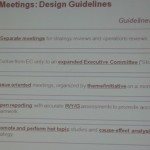Target setting – insights from the Balanced Scorecard Forum 2011 Dubai
One of the workshops held at the Balanced Scorecard Forum 2011 Dubai, Executing Strategy with Balanced Scorecard, facilitated by Aldo Labaki & Roberto Wyszkowski, Palladium UAE, generated an environment of open discussions, including time allocated to questions and answers.As some participants were considering to implement Balanced Scorecard in the near future or others were at their first months of implementation, a question that was raised was how to set the targets for the first time, when no history of data is available.
Answers were offered both by participants that were using the Balanced Scorecard for some time now, and by the facilitators. Some options mentioned for setting the targets for the first time in a BSC implementation were:
- Benchmarking – setting targets according to the best in class results; however, this was intensely debated, as data may not be available or public for some Key Performance Indicators (KPIs) or it may be difficult to obtain;
- Set targets that can be reached – first agreeing on some targets that seem to be achievable and than increase the stake, for this method can increase the confidence of reaching higher targets;
- Measure first, than set targets (Palladium UAE, 2011).
As literature is concerned, one of the most thorough and insightful articles on the topic is considered to be “How to avoid the problems of target-setting” (Meekings, Briault & Neely, 2010), presented at the 2010 PMA Symposium in Scotland. The article covers topics such as:
- Understanding the typology of targets;
- Clarifying the terminology used;
- Distinguishing between differing uses of measures;
- Adopting a systemic perspective;
- Acknowledging the unknown and unknowable;
- Charting performance;
- Differentiating managerial time spans of attention and added value from front line to boardroom (Meekings, Briault & Neely, 2010).
As this article mentions, the critics of target setting point out issues such as:
- If set too high, they create stress and de-motivation;
- If set too low, they encourage complacency;
- If imposed, they are unlikely to be owned by those who have to deliver them; and
- If negotiated, there is an incentive to press for lower targets that are easier to meet, thereby creating tension and suspicion between managers (Meekings, Briault & Neely, 2010) .
Target setting has its advocates and critics, remaining a highly debated topic nowadays, both in business practices and in academic literature. No matter the context, target setting should serve a greater purpose than just measuring performance, for it may be a key process in managing and improving performance.
References
Palladium UAE (2011),Pre-Forum Workshop A – Executing Strategy with the Balanced Scorecard, Balanced Scorecard Forum 2011, Dubai.
Meekings, A., Briault, S. & Neely, A. (2010), How to avoid the problems of target-setting, PMA Symposium, Scotland.
–If set too high, they create stress and de-motivation;
–If set too low, they encourage complacency;
–If imposed, they are unlikely to be owned by those who have to deliver them; and
If negotiated, there is an incentive to press for lower targets that are easier to meet, thereby creating tension and suspicion between managers.
Tags: Benchmarking, Targets






